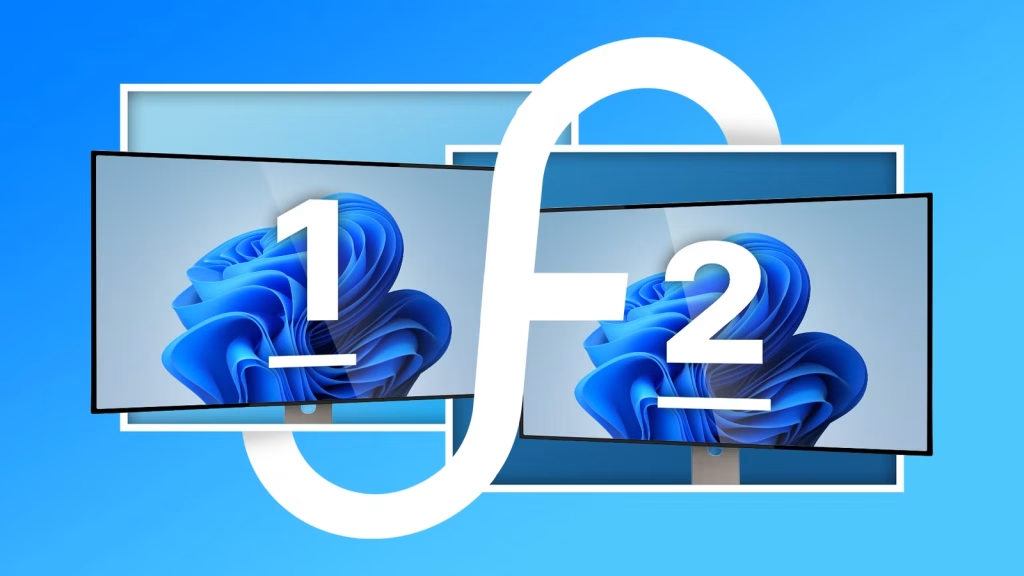If you’ve ever run more than one monitor, you know how messy things can get. Windows has come a long way with tools like Snap Assist and FancyZones, but it still struggles to make multi-monitor setups feel truly seamless. That’s where DisplayFusion comes in.
I’ve been using it to manage my three-monitor setup, and it’s made a noticeable difference. From smarter window management to taskbar tweaks that make sense, it gives me more control over how my screens behave and look. It’s not perfect, and some of its features now overlap with built-in Windows tools, but there’s still plenty of reasons I keep it around.
The utility that made Windows play nice with more than one screen
I’ve used multiple displays for a long time, and back in the Windows XP days, managing multiple displays was more difficult. It meant dealing with awkward resolutions, wallpapers that didn’t stretch correctly, and one taskbar that was firmly anchored to your main screen. If you wanted true multi-monitor control, you had to dig through settings or rely on half-baked third-party utilities. That’s when DisplayFusion came along.
It gave people like me exactly what Microsoft hadn’t yet delivered, proper multi-monitor taskbars, better wallpaper management, and powerful window controls. It was clean, reliable, and made dual or triple monitor setups work better. For gamers, editors, and developers, it became a must-have utility. And even as Windows caught up over the years, DisplayFusion built up a loyal base that has stuck around for its flexibility.
The advantages that keep DisplayFusion relevant
Even with Windows and PowerToys catching up, DisplayFusion still has a few tricks that make it worth keeping in your toolbox. Its window management options are just more flexible. You can build specific layouts across multiple screens, move windows exactly where you want them with a single hotkey, and save those positions so everything snaps back into place when you reboot. Windows can handle the basics, but DisplayFusion still feels more intentional and customizable, especially if you’re running an ultrawide or a three-monitor layout like mine.
Wallpaper control is another area where it still shines. DisplayFusion lets you assign different images to each screen, pull from online sources, or stitch a panoramic shot across every monitor without distortion. It sounds minor, but once you get used to that level of control, going back to Windows’ limited options feels like a downgrade.
And then there are the small quality-of-life features that quietly make a difference like per-monitor taskbars you can actually customize, profile switching that recognizes when your setup changes, and little automation touches that save time. For most people, Windows’ built-in tools are enough. But if you want a setup that feels dialed in rather than “good enough,” DisplayFusion still earns its spot.
Why DisplayFusion isn’t the default choice anymore
As much as I appreciate what DisplayFusion brought to the table, its competitors have been catching up. A lot of what once made it essential is now built right into Windows or handled better by Microsoft’s own tools. Between Snap Assist, FancyZones (via PowerToys), and even the simple improvements to multi-monitor taskbars in Windows 10 and 11, there’s less reason than ever to install a third-party utility for basic display management.
Performance is another sticking point. DisplayFusion is feature-rich, but it’s heavy. It can add a bit of startup drag, and I’ve occasionally noticed lag when switching monitor profiles or snapping windows between screens. The interface, while functional, also feels dated, like a throwback to the Windows era it came from. It’s not broken by any means, but it doesn’t have the streamlined feel modern Windows tools offer.
Then there’s the overlap problem. FancyZones handles window snapping beautifully, the Windows taskbar finally extends properly across multiple monitors, and wallpaper management is easier than ever. Even niche utilities like PowerMenu or AquaSnap do parts of what DisplayFusion offers with less overhead. Unless you need its advanced triggers, scripting, or automation, most users will find that Windows has quietly caught up, and in some areas, even surpassed it.
Where DisplayFusion still makes sense
DisplayFusion is no longer for everyone, but there is still a specific group of users who can genuinely benefit from it. If you’re running an ultrawide, a triple-monitor layout, or any setup that mixes orientations and resolutions, DisplayFusion offers a level of precision that Windows and PowerToys don’t quite match. Its custom window layouts, per-monitor taskbars, and profile switching are still incredibly handy when your workspace is more complex than the average dual-monitor desk.
It’s also worth keeping around if you love deep customization. Windows gives you the basics, but DisplayFusion lets you dial in every detail. You can adjust wallpapers, snapping behavior, hotkeys, triggers, and even perform small automation tasks. If you’re the type who wants your monitors to behave exactly the same way every time you sit down, this tool still delivers.
For everyone else, Windows’ built-in tools will likely feel simpler and lighter. But for power users, DisplayFusion still earns its place.


